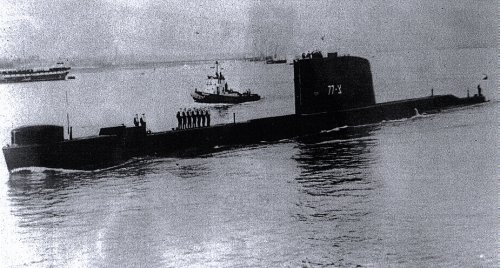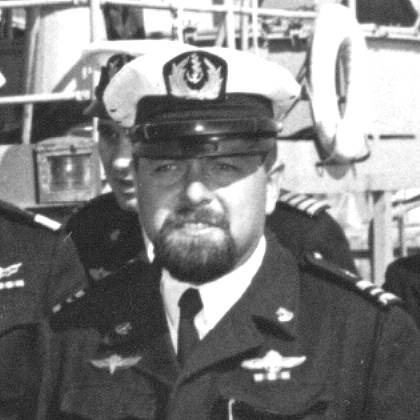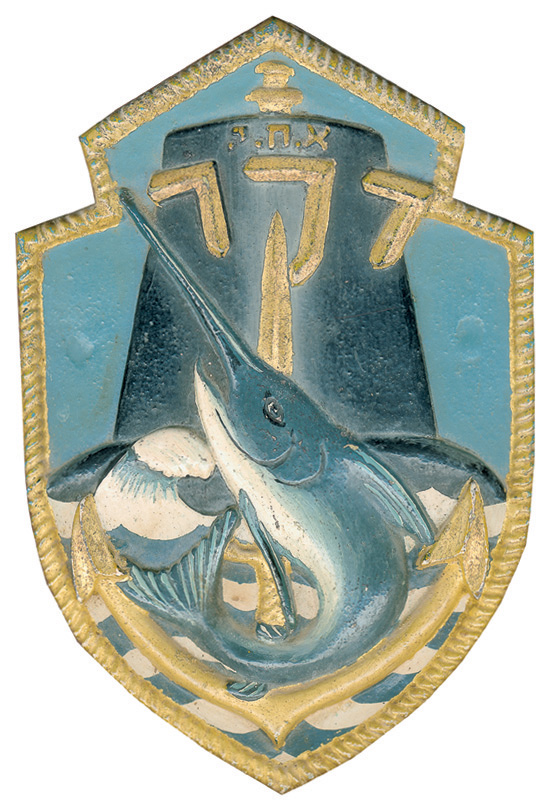|
Israeli Navy Submarine Dakar
 INS Dakar was a British T-class, third group (welded hull, as opposed to riveted one) submarine. In 1965 she was purchased by Israeli government, together with her two sister submarine INS Leviathan ex HMS Turpin, from the Royal Navy. The submarine was built by H.M. Dockyard in Davenport and was launched as HMS Totem on September 28, 1943. In the mid 50`s the submarine under went an extensive overhaul and refitted giving the boat the designation of a `T conversion class`. 12 feet were added to the length of the pressure hull, the deck gun was removed, 2 more electrical motors were put in and the boat was streamlined with an enclosed new conning tower and a distinctive new large fin which was constructed. INS Dakar was a British T-class, third group (welded hull, as opposed to riveted one) submarine. In 1965 she was purchased by Israeli government, together with her two sister submarine INS Leviathan ex HMS Turpin, from the Royal Navy. The submarine was built by H.M. Dockyard in Davenport and was launched as HMS Totem on September 28, 1943. In the mid 50`s the submarine under went an extensive overhaul and refitted giving the boat the designation of a `T conversion class`. 12 feet were added to the length of the pressure hull, the deck gun was removed, 2 more electrical motors were put in and the boat was streamlined with an enclosed new conning tower and a distinctive new large fin which was constructed.
On November 10th 1967 she was commissioned by the Israeli Navy. Under the command of Lieutenant Commander Ya`acov Raanan (Frisch) the Israeli Navy ensign was hoisted and she was given a Hebrew name, Dakar, which is Hebrew for spineback, a type of fish. Right after the commission ceremony Dakar left for Scotland for her sea and dive trials and crew shake-down training.
Dakar stayed in Scotland for almost 2 months undergoing her sea trials supervised by Royal Navy`s and Israeli`s experts. Towards the end of December 1967 Dakar returned to Portsmouth and made preparations for her voyage to Israel.
The voyage of the Dakar
On January 9th 1968 Dakar was ready to cast off and leave for her long voyage to Israel. Just before her departure another ceremony took place. A third T class submarine was purchased; HMS Truncheon became INS Dolphin and delivered to the Israeli Navy on the same day. After a short ceremony, on a gray wintry day, INS Dakar left slowly the submarine pier at HMS Dolphin at Portsmouth Navel Base and started her ill-fated journey.
Six days later, on the morning of January 15th Dakar enters Gibraltar for refueling, adding fresh supplies and changing a few crew members. At midnight, the same day, Dakar cast off and left Gibraltar. It was the last time that the Dakar and her crew were seen.
 Ya`acov Raanan, skipper of the Dakar had received his orders from the Navy headquarters in Haifa and Dakar should have made her way across the Mediterranean submerged, her snorkel. According to established submarine procedure Dakar radioed her position to the HQ in Haifa, every 24 hours, and radioed a control telegram every 6 hours. Dakar should have entered Haifa Naval Base, her home base, on Friday, February 2nd. As the Dakar was making a faster progress than expected, Raanan requested permission to enter port earlier. He got an approval to enter on January 29th. Later Raanan requested to enter yet another day earlier, on January 28th. This request was denied by the HQ, as the welcoming ceremony had already been planned. Ya`acov Raanan, skipper of the Dakar had received his orders from the Navy headquarters in Haifa and Dakar should have made her way across the Mediterranean submerged, her snorkel. According to established submarine procedure Dakar radioed her position to the HQ in Haifa, every 24 hours, and radioed a control telegram every 6 hours. Dakar should have entered Haifa Naval Base, her home base, on Friday, February 2nd. As the Dakar was making a faster progress than expected, Raanan requested permission to enter port earlier. He got an approval to enter on January 29th. Later Raanan requested to enter yet another day earlier, on January 28th. This request was denied by the HQ, as the welcoming ceremony had already been planned.
At 06:10 hours, on the 24th of January 1968, Dakar just passed Crete and transmitted her last known position, 34.16N, 26.26E. In the next 18 hours Dakar radioed 3 more times. All of them were control transmissions, which did not include her position. Two minutes after midnight on January 25th, Navy HQ received the last coded telegram from the Dakar. The next radio message should have been received at 06:00 hours, on the next morning, Israeli time. Nothing was received from the Dakar at that time. Listening for the Dakar was intensified and radio messages were sent to her. It was assumed that she was experiencing communications difficulties. During that day, Dakar was repeatedly called using her international call sign, 4XP-Z. No further signals came from Dakar.
On the morning of the 26th of January an international Search And Rescue operation was launched. All available Israeli ships and airplanes joined the SAR efforts. Navy and air units from Great Britain, the USA, Greece, Turkey and even Lebanon took part in the SAR efforts. On the 27th of January, a radio station in Nicosia, Cyprus, received a SOS call on the frequency of Dakar’s emergency buoy. It was assumed that the transmission was sent somewhere from south east to Cyprus. This area was searched without any results.
On January 30th, the search and rescue operation HQ in Cyprus determined that chances for the submarine still to survive were close to nil. It was decided to stop all search efforts 24 hours later. All foreign forces ceased the search at the sunset of the 31st. Israeli forces continued the search for another four days. As the sun went down on the day of February 4th, 1968 all ships and planes returned to their home bases. The search for INS Dakar was called off.
The emergency buoy
 On February 9th 1969, a year after Dakar`s disappearance, an Arab fisherman found Dakar`s stern emergency buoy marker on the coast of Khan Yunis, an Arab village south-west of Gaza. The Dakar had 2 such buoy markers. One at the bow the other at the stern. They were secured behind wooden doors in cages under the deck and attached to the submarine with metal cables 200meters (600ft) long. Those doors could be opened from the inside of the submarine. When a submarine is unable to surface, the crew can open the doors and the buoy will surface and transmit for the next 48 hours an SOS message. The location of the sunken submarine can then be determined by radio direction finders. Part of the cable (65cm) connecting the buoy to the Dakar was found, attached to the buoy. On February 9th 1969, a year after Dakar`s disappearance, an Arab fisherman found Dakar`s stern emergency buoy marker on the coast of Khan Yunis, an Arab village south-west of Gaza. The Dakar had 2 such buoy markers. One at the bow the other at the stern. They were secured behind wooden doors in cages under the deck and attached to the submarine with metal cables 200meters (600ft) long. Those doors could be opened from the inside of the submarine. When a submarine is unable to surface, the crew can open the doors and the buoy will surface and transmit for the next 48 hours an SOS message. The location of the sunken submarine can then be determined by radio direction finders. Part of the cable (65cm) connecting the buoy to the Dakar was found, attached to the buoy.
Scientists and experts examined the buoy and the cable number of times and determined that the buoy was attached to Dakar for a year until the cable was torn completely and the buoy broke free to the surface. It was determined that the Dakar rests in depth between 150 to 326 meters (the collapse depth of the buoy which was found almost intact), and that she is 50-70 nautical miles away, to the South, from her planned route (examining marine life form attached to the buoy, judging the position it was found and analyzing currents in the eastern part of the Mediterranean).
Search and no discovery
For 31 years Israel never ceased her effort to find her lost sons. One of Israel`s strongest traditions is to bring home all killed and missing soldiers. In Israel`s 52 years of existence she paid dearly for getting the remains of her MIA warriors. Jews will do their outmost in order to give a proper Jewish burial to every Jewish deceased.
A committee was nominated to investigate the possible reasons for the lost of Dakar and recommend search areas to look for her. The Israeli Navy committee thus concluded that the submarine was off the Egyptian coast at a maximum depth of 350 meters. After the peace treaty with Egypt, searches were conducted in Egyptian coastal waters, from Alexandria and eastwards towards Dumyat/Port said but without results. Following new research on current patterns conducted by Israel, Turkey, Greece, and Italy under US supervision, it was decided to search in the Aegean Sea, around the north-eastern shores of Crete. The searches however were inconclusive and on April `97, a new round of searches was launched with the help of the US Navy off the Sinai coast.
For 31 years the search went on, almost year after year. 25 search missions were launched; every expedition searched a different part of the eastern Mediterranean shores. Along the years more advanced methods and techniques were used together with the development of the marine and deep-sea science and technology. For 31 years all effort was in vain.
As weird as it sounds, the only area that was not checked was along Dakar`s route to Haifa. Along a virtual course between her last known position point and Haifa.
Why did it take 31 years to find Dakar where she logically should have been?
The answer has 2 parts; One is the emergency buoy marker that was washed to the coast of Khan Yunis a year after Dakar`s disappearance and the other part of the answer is the advanced techniques for deep sea exploration that were developed along the last 3 decades and became handy towards the end of the 90s.
A new approach
Today, after the rediscovery of Dakar it is clear that the conclusions of sea experts and marine scientists were false and misled the search operations for 31 years. Dakar never diverted from her planned route and her wreck rests in a depth of almost 3,000meter (10,000feet). The emergency buoy marker was not attached to the submarine during the first year. It must have been cut-off at the accident time. It is not out of question that the radio station in Nicosia really did receive the emergency call radioed by the emergency buoy. It then took most of the passing year for the buoy to drift southeasterly direction toward the eastern shores of the Mediterranean.
In 1998, after 25 barren search missions, the CIC of the Israeli Navy, Admiral Alex Tal dismissed the previous search committee and nominated Rear Admiral (ret.) Gideon Raz as head of the new committee. All previous search missions concentrated in relatively shallow waters according to the buoy research conclusions. This time, Raz and his committee members consulted US Navy experts and scientists of deep water research. Based on new deep water technology, satellite advanced technology and calcified information obtained from the US Navy about the Mediterranean currents, led to a new conclusion. The Israeli Navy published a tender for companies specializing in underwater searches. The company which was awarded the bid had located the remains of the Titanic and a Japanese submarine which had been sunk in WW-II.
At last a fruitful search
It was decided to concentrate the search efforts along the path of the original route. The American marine contractor Nauticos Corporation was hired with Tom Dettweiler as expedition leader and at the end of April 1999 the 26th attempt to find the lost submarine was launched.
On 9 May 1999 the two charted sea vessels arrived at the search area. The designated search frames box area was approximately 60 nautical miles long, nearly 8 nautical miles wide and contained 16 search lanes. With a speed of 2 knots per hour it takes between 30 to 40 hours to monitor the sea bed of each search lane.
Searching was conducted using the AMS-60, a wide-swath sonar and the REMORA 6000, a remotely operated vehicle (ROV) equipped with both video and still cameras.
At the evening of May 24th the sonar detected the presence of a large body resting on the seabed. The team was able to view on the monitor a large black spot and a scattering of smaller dots around it. Dettweiler ordered to winch down the ROV, a remotely operated vehicle equipped with both video and still cameras, in order to conduct a more specific visual survey and make a positive identification. Bad weather delayed the investigation for another 3 days. At 07:00, on May 28th the ROV dove and 4 hours later it started to transmit pictures to the ship 2900 meters above. There was no place for doubt. It was clear that those are the remains of a submarine. The submarine rests on her keel, her bow points to the north-west; the hull is broken in two between the engine room and the stern. The conning tower is ripped off and on its side, as the forward part of the coning tower (the bridge/fin) lies 230 meters away. The stern of the submarine, with its propellers and dive planes, broke off the submarine and rests not far from the main hull.
Navy headquarters in Tel-Aviv was informed of the finding on Friday May 28th; a team of three former commanders of submarine squadron were rushed to the search area on the deck of a fast missile boat. Rear Admiral Raz, Commander Amir and Commander Keisari carefully examined the video film, searching for details characteristic of the Israeli T-class boats. A few hours later they gave the final confirmation that the lost submarine, INS Dakar had finally been foun d. d.
It was Friday, Sabbath`s eve, and at 8:00 PM, all news broadcasting started with the words that sent a shiver through the nation:
INS Dakar was found, 500 kilometers (or 270 n/miles) away from the Israeli shores, on the bed of the Mediterranean, in 2,900 meters of waters (9,514 feet), the Dakar rests.
A Memorial in Haifa
On 11 October 2000, Dakar`s bridge and forward edge of her sail were raised, and are now a memorial display in the Naval Museum in Haifa.
From an article published by The American Society of Mechanical engineers-August 1999:
The sub offered a choice of two drives, a diesel-electric mode where the propellers were driven by electric motors with the diesels producing the electric power, and a faster (about 8 knots) direct-drive mode where the diesels were connected directly to the propellers through a pair of clutches. Direct drive was not recommended for long periods, and it imposed an extra strain on the crew, requiring two officers to be on watch at all times. What`s more, under direct drive a loss of hydraulic pressure could cause the stern plane—a sort of horizontal rudder that controls the dive angle—to jam in full dive position. The crew would have to manually disengage the clutch, which was normally operated hydraulically, in order to reverse engines so that the sub would not continue its dive straight to the bottom.
The modifications to the Dakar had reduced its maximum operating depth to 300 feet from 350. As Cmdr. Jonathan Powis, the staff officer for submarines at the British Embassy in Washington, pointed out, after the alterations the sub would have been almost 300 feet long, so "it wouldn`t take long to achieve the diving depth." Powis, however, said that loss of hydraulic power would not normally lead to catastrophe, because of the redundancy built into the systems. It was clear, however, from the sub`s rate of advance on its trip home that it was, in fact, operating almost continuously in direct drive.
Full-scale tests, including a dive to 300 feet, were conducted prior to delivery. The Israelis chose the name Dakar, which is Hebrew for spineback, a type of fish.
The Dakar`s orders were to make a direct course via Gibraltar to Haifa and to arrive February 2. The vessel, under the command of Lt. Cmdr. Ya`acov Raanan, was advancing at a speed of 8 knots, and the captain asked to have his arrival moved up to January 28. Actually, the boat kept up a speed that would bring it to Haifa on the 26th, a feat that would have set a record for crossing the Mediterranean submerged.
Back to History Index
 |
Israel |
1999 |
Submarine Memorial Sea Ceremony 2ed November 1999 (souvenir leaf). The souvenir was issued by israel Post Authority-Philatelic Service to commemorate the crew of Israeli Navy Submarine Dakar that sank on 26, January 1968 at the eastern waters of the Mediterranean and was found on 28,May 1999. This leaf eas prepared and distributed to the attendees of the sea ceremony and the families of those that perished. INS Dakar ex HMS Totem was a British T-class submarine |
|